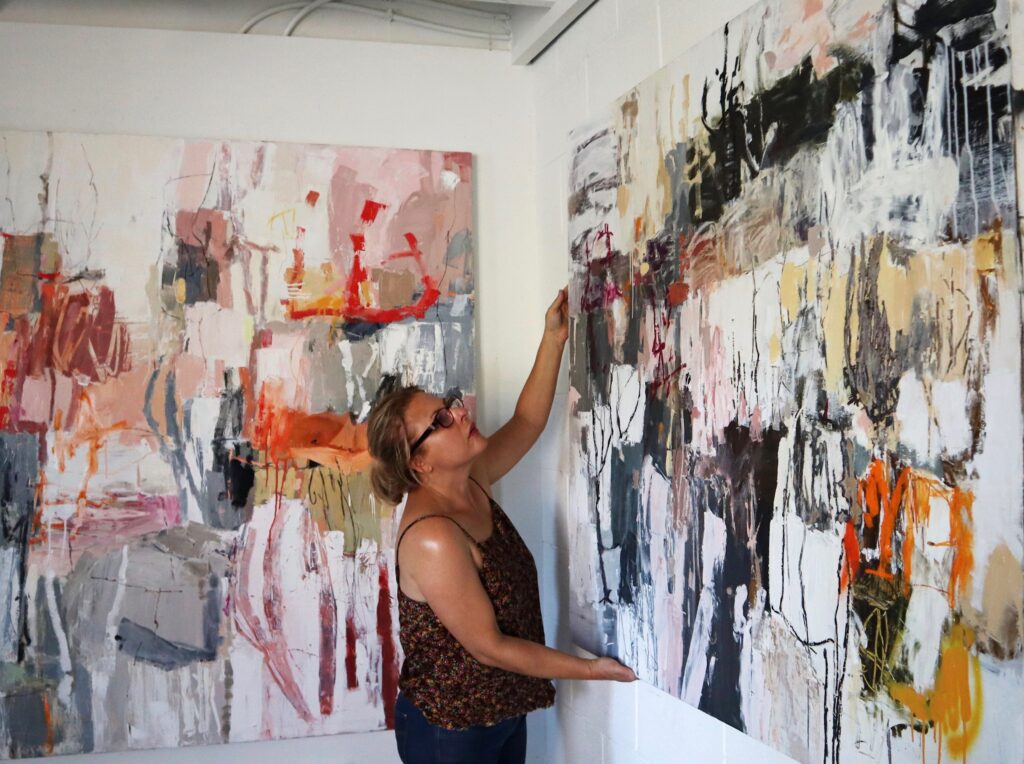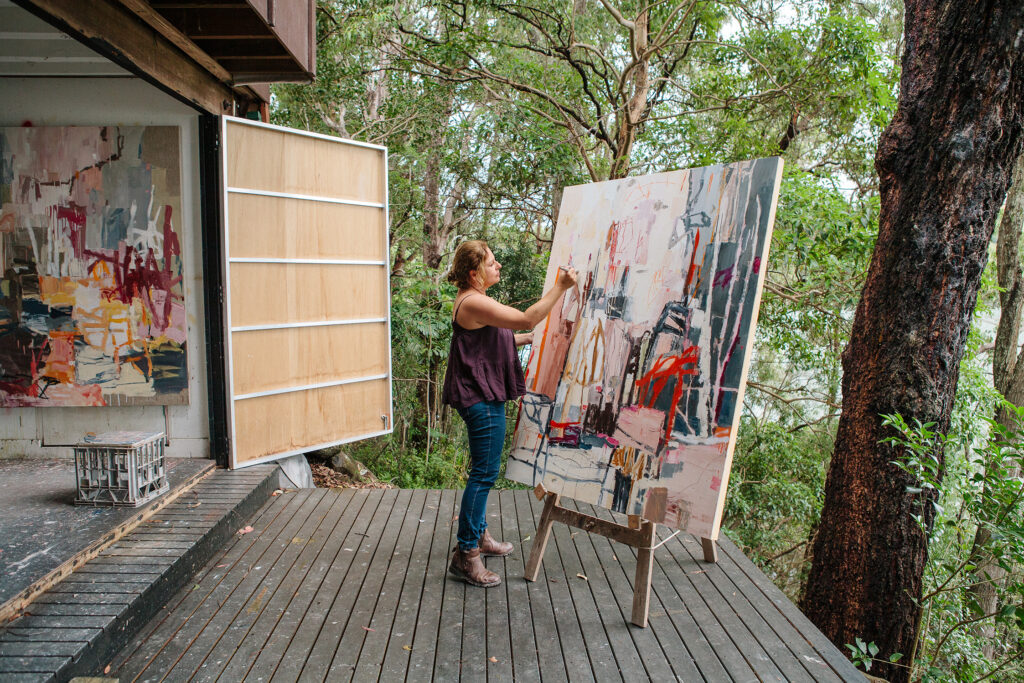
I have a deep affinity for the land, it’s a place for immersion, to experience and be absorbed.
My work taps into the emotional gravity of a place, its memory, its pulse, its rawness and power. For me the paintings communicate a deep felt relationship with the earth, embodying a spirit of place and its atmosphere.
The images are a direct emotional response to the bush, beaches and mangroves that surround my home. My paintings explore unique ways of capturing the diversity of the natural terrain. I am interested in local flora, protected plant species, seaweeds and noxious plants. I often start my paintings with the small delicate details found in the bush and then depart to a place of frantic energy.
The course of painting is a primal impulse to mark. It is a physical and emotional experience. I paint in an expressive and gestural way capturing the force and energy of a place. I create a visceral experience through the use of mark making and the application of paint. My paintings are process driven and it is only through the act of painting over, scraping back and drawing into, that my work is resolved.
‘The sense of place…does indeed emerge from the senses. The land, and even the spirit of the place, can be experienced kinetically…as well as visually….a place can be felt as an extension of the body, especially the walking body, passing through and becoming part of the landscape’. Lucy Lippard
Leah Thiessen: Biome
Flinders Lane Gallery
Words: Sharne Wollf
Put simply, Biome is a word that refers to a biological community formed in response to place. Reflecting this idea, Leah Thiessen’s new solo exhibition is inspired by her working environment and it’s hard to imagine writing about the show without experiencing her magical studio. Surrounded by tall gums, Thiessen’s workroom overlooks the Terranora Broadwater, a large tidal bay which forms part of the Tweed River estuary in far north New South Wales. Immersed in this unique space with its shimmering light and tranquil feel, Thiessen’s paintings embody the subtle essence of this natural place.
For the body of works in Biome, Thiessen has worked in oils. Side by side we can observe contrasts between the softer palette of the works on canvas and linen with the physicality of those on board. Employing a harmonious palette of joyous pinks, warm oranges and yellows and a range of tonal blues together with black and white, the depth and strength of colour in Thiessen’s abstracts is often linked to her output of physical energy. While nature is an important inspiration, her paintings are not of specific places seen or observed, nor is her work derived from photographs. Rather, each painting is created instinctively, expressively and viscerally from things – both tangible and intangible – that become seized in the artist’s mind. Liberated from order she begins a painting with fresh marks and builds the textural surface, layering paint over and over. “I want the mystery – I want to be lost in the painting and not know where I’m going”, the artist reveals.
While Thiessen finds painting on canvas and linen is a fluid, gestural process, her boards are approached with gusto – she’ll employ oil sticks and ink, carving into the board, scraping and drawing and sometimes using spray paint. As the process of making continues – sometimes over months – shapes appear and recede, portals reveal themselves and evaporate. Can we be certain then of what we think we see? Fleeting shapes in the forest? Sunlight flickering on the bay? Beckoning pathways and open doors? Or maybe not. Alive with possibility and suggestion, Thiessen’s energised images keep the eye active and allow viewers to become captivated by what they see.
When Thiessen says that painting is her way of connecting, of expressing things that are unknown even to her, she invites us to become familiar with her artistic language and to feel the power of her art. As well-known New York art critic, Jerry Saltz puts it, “…careful observation reveals how powerful abstraction can be, how it is still a tool that circumvents language, disrupts identification, dissolves narrative, delays the crystallization of meaning, and becomes a reality unto itself.”

Leah Thiessen: Broadwater
Flinders Lane Gallery
Words: Emma O’Neill
It is through the rhapsodic brushwork and peculiar scrawls of her practice that Leah Thiessen makes sense of the inherent chaos and beauty of the natural world. The dappled light and complex composition of each piece in Broadwater reads like a visual score of her immediate surroundings. One can almost hear the rustle of trees, the splash of waves, the cicadas descending into a shimmering hum as the setting sun sends a golden light through her studio. It is that place in Terranora Broadwater in Northern NSW, from which the exhibition takes its name. It is that place where the artist’s practice begins and ends.
Frenetic, lyrical and raw – each work in Broadwater is a dance of colour and line. What strikes the viewer is Thiessen’s ability to translate the lush, untidy and strange Australian wilderness with a colour and pace that is all her own. The ability has come from years being at it’s edge: in that time, “the landscape has become part of my psyche,” she tells me. While the titles of each work provide a visual cue of their origin, the lines diverge in unexpected turns to emulate the pulse of the landscape. Even the rhythm of the artist’s practice follows the ebb and flow of the tide or the cycles of the sun.
Guided by instinct, the artist’s palette can change several times during the course of making a single painting. “There are times I have seen my work move from very dark brooding colours to a whitewash of paint,” she explains. “I’m not attached to the image; I’m more interested in the process of abstraction. I lose myself in the work and try to find my way back.” Some canvases start off bare, while others are revisited. The bigger the canvas, the greater chance of surrendering to this creative process.
Thiessen isn’t beholden to a single medium. Moving between oil paint, spray paint, enamel, pencils, oil sticks and ink across large canvases, the artist builds thick layers that juxtapose the fine base of raw linen or canvas. The resolute magnetism of each piece is testament to the artist’s acute awareness of this layering, as well as the accretion of time and discipline required to produce works that combine a melange of colour yet culminate in sustained surfaces and compositional balance. Words fall short to describe this approach, it is purely intuitive.
And while the artist loves things as they are (for reprieve, she turns to botanical drawing), abstraction serves as an essential mode of discovery of both her immediate exterior and interior psychological terrain. She professes that painting is her most difficult reckoning, the place where she works hardest on equilibrium (both its creation and rupture). This deep work results in surfaces that vibrate in a way that is at once feverish and soothing. Over a single piece, Thiessen finds new contexts and her brushstrokes continue in ungoverned pathways. Ultimately, there is always a place where the eyes can rest amidst the dance.
